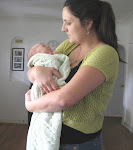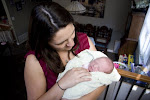Bleeding During Labor
This sort of bleeding can be due to separation of the placenta from the uterine wall (placenta abruption), or a placenta that is too close to the cervix or covering it (placenta previa).
1. Witch Hazel Bark Tincture (10-20 drops) repeatedly under the tongue can assist in controlling the bleeding until the placenta is birthed.
2. Repeated doses of Bach Flower Rescue Remedy, reassurance and visualizing positive results can help the mother to remain calm.
Placentas can handle a loss of function and still be able to support their babies through birth but if you feel assistance is warranted, do not hesitate to seek it out.
If there is a great urge to push before full dilatation a lip or cervical swelling can occur.
1. Homeopathic Arnica 200C (3-5 pellets). Dosing again after baby is born. Continued use of 30C for several days postpartum for soreness.
If the mother is in shock, Keep the mother warm, awake, talking and in a position where her legs are kept elevated.
1. Homeopathic Arnica 30x (3-4 pellets) every 5 minutes can stabilize and reverse shock.
2. Gatorade or , 1 teaspoon table salt, ½ teaspoon sodium bicarbonate (baking soda) dissolved in 4 cups warm water can be given.
Fainting Postpartum:
1. Place mother in shock position.
2. Place burnt hair, piece of placenta or Rescue Remedy under tongue.
Bleeding after Birth / Hemorrhage
Hemorrhage is defined as more than 2 cups of blood (500ml) lost either by a slow seeping or a sudden gush. The slower hemorrhage is the most dangerous one as it is easy to overlook where the sudden massive hemorrhage is more obvious.
- More than 2 cups (500ml) of blood lost
- Fainting or passing out
- Dizziness or nausea
- Shortness of breath
- The fundus (abdomen) may seem to be expanding (a sign of hidden bleeding)
For bleeding before the placenta is out
DO NOT PULL ON THE CORD OR PRESS ON THE UTERUS UNTIL YOU ARE POSITIVE THE PLACENTA HAS DETATCHED FROM THE UTERINE WALL FULLY.
1. Breastfeeding, kneeling, squatting, standing up, having a pee, and walking around can encourage the placenta out.
2. Witch Hazel Bark Tincture (10-20 drops) repeatedly under the tongue can assist in controlling the bleeding until the placenta is birthed.
3. Angelicia Tincture (30-50 drops) single dose under the tongue can work within 5 minutes to encourage contractions and to bring the placenta out. If contractions do not resume in 15 minutes, repeat the dose once.
For bleeding after the placenta is out
Check the placenta. If pieces appear to be missing, try taking steps to aid expulsion of the placenta (pieces) as well as the following steps for hemorrhage.
1. Breastfeeding for oxytocin release.
2. Witch Hazel Bark Tincture (10-20 drops) repeatedly under the tongue can assist in controlling the bleeding until the placenta is birthed.
3. Uterine massage after the placenta is out is beneficial to helping the uterus clamp down and shrink.
4. Eat your placenta. Slice a pieces off the maternal side (side without cord) of the placenta with a sharp knife.
5. Shepherd’s Purse Tincture (20-40 drops) under the tongue. This can stop a post-partum hemorrhage in 5 seconds flat. The longest a midwife has reported this tincture taking is 30 seconds. Repeat as needed or every couple minutes. Take as last Resort! Can cause clots.
Shoulders Stuck
1. Gaskin maneuver. Change position.
2. With both hands pull down on mother’s abdomen during a contraction.
3. Hook a finger under the arm of the baby that is toward the mother’s back. Rotate the hooked shoulder toward the baby’s face.
Cord Around Neck
1. Continue birthing instinctively.
If the cord seems to be too short to allow the baby to descend, and the mother senses a real problem, it may be necessary to clamp and cut the cord for her to be able to birth the baby.
2. Clamp in two places and cut between them. Once the baby is out take off the maternal clamp allowing blood to flow freely.
Cord Prolapse
This is when the cord or part of it comes out by itself or with a hand or foot.
1. In some cases, it is possible to push the cord back in quickly. If this is not possible, wrap the cord in a warm, wet and clean towel to avoid air exposure triggering the cord vessels from constricting.
2. If birth is imminent and the woman is feeling strong desires to bear down & birth, she should be allowed to do so (except in the case of a hand presenting) as time is of the utmost importance.
3. If there is no urge to push and birth is too far off, get the mother’s head, chest and shoulders flat down on the ground with her butt up in the air until medical assistance can be provided to her.
Baby Not Breathing
It is normal for babies to take time to begin breathing after they are born, particularly with water births. If the baby is purple, red, pink, holding arms and legs stiff, making faces, or just has pale blue/white arms/legs, just wait. He/she will breathe.
1. Keeping the baby warm, skin to skin, talking to the baby, rubbing the baby’s back, laying the baby face down over your thigh with their bum higher than their head.
2. Flick at the soles of the baby’s feet with your fingertips to encourage a gasp reflex.
3. Rub Bach Flower Rescue Remedy on the newborn’s wrists, temples and lips.
4. Dilute one drop
5. Homeopathic Carbo Veg. (Crush one tablet and put a pinch under tongue).
However if a baby is:
- pale blue or white
- limp
- looks almost dead
1. Start mucus clearing and resuscitation efforts while an ambulance is called. To clear mucus, suck it out of their mouth and nose gently, and/or have them laying on their belly, upside down on your leg while you rub their back talking to them.
2. Hold the baby’s body in two hands with palms up. One hand under hips and one under the shoulders holding the head at the middle position (parallel to body). Gently raise and bend hands bending hips toward shoulders, like a hinge. Lower hands. Repeat every 5 seconds.
3. When a pulse is detected: Start artificial breathing (only after airways are clear). Support the infant's head. Cover infants mouth and nose with your mouth and give 2 gentle puffs of air from your cheeks, only sufficient to make the infants chest rise. After the initial 2 puffs, check the pulse. If there is a pulse but no breathing, continue to inflate the lungs at a rate of 20 times per minute (every 3 seconds). Check the pulse about every minute. Note: Infants pulse can be found on the inner upper arm (brachial pulse).
4. When no pulse is detected: Use 2 fingers (index and middle) over lower half of sternum (one fingers breadth below the inter-nipple line) to give chest compressions. Compress chest approx 1/3 depth of chest. Give 5 chest compressions in 3 seconds followed by 1 breath.
Don’t give up.



No comments:
Post a Comment